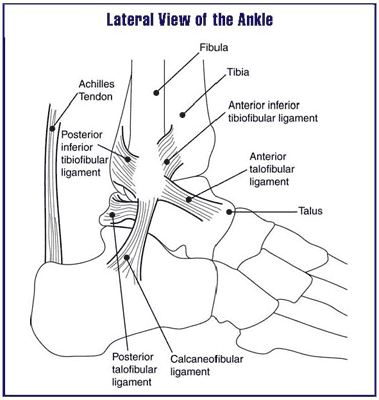achilles tendon problems
Displaying items by tag: achilles tendon problems
Wednesday, 08 February 2023 17:42
Dr. Timothy Young, a Board-Certified Foot Surgeon, Discusses Insertional Achilles Tendon Problems

Dr. Timothy Young, a Board-Certified Foot Surgeon, Discusses Insertional Achilles Tendon Problems
Achilles insertional calcific tendinosis. This is a common problem at the insertion point of the Achilles tendon. This very often has chronic degenerative changes within the tendon which are therefore considered tendinosis. And often times there are also calcific changes or even radiographic appearing bone at the insertion of the tendon. This is a process where the Achilles tendon becomes degenerative and over time calcified is and over a longer period of time the calcification here becomes larger and can become essentially bone, that is seen on x-ray. Regarding the cause of this condition, some of it is due to overuse, it may be due to mechanical shearing and the individuals biomechanics or sport specific. A large muscular calf and/or a tight calf definitely plays into all Achilles problems. Men seem to be more prone to this than women.
Especially very large areas of calcification with men. Although women can get a condition that similar but different called a Haglund deformity. In this case it is the bone on the posterior aspect of the calcaneus that protrudes and can be aggravated by the adjacent Achilles tendon and not intratendon calcification. In the early stages this is very treatable. As time goes on and there are large areas of calcification, they can cause chronic problems. As I mentioned, in the early stages this response to some of the classic treatments for Achilles problems. That means a special brace, orthotics to decrease the workload and side to side mechanical shearing of the tendon at the insertion point, calf stretching and related treatments, and shockwave therapy. The later stages the same treatments are often still helpful, but they may not offer full relief. These are the individuals that often require surgery. The surgery involves access to the back of the Achilles insertion point with removal of the calcific portions and then reattachment of the tendon itself. The healing process for this can be similar to an Achilles rupture. There are new anchors that help to give more reliable surgical reattachment of the Achilles to the underlying bone.
If you are experiencing foot or ankle pain, give us a call at 425-391-8666 or make an appointment online today.
Especially very large areas of calcification with men. Although women can get a condition that similar but different called a Haglund deformity. In this case it is the bone on the posterior aspect of the calcaneus that protrudes and can be aggravated by the adjacent Achilles tendon and not intratendon calcification. In the early stages this is very treatable. As time goes on and there are large areas of calcification, they can cause chronic problems. As I mentioned, in the early stages this response to some of the classic treatments for Achilles problems. That means a special brace, orthotics to decrease the workload and side to side mechanical shearing of the tendon at the insertion point, calf stretching and related treatments, and shockwave therapy. The later stages the same treatments are often still helpful, but they may not offer full relief. These are the individuals that often require surgery. The surgery involves access to the back of the Achilles insertion point with removal of the calcific portions and then reattachment of the tendon itself. The healing process for this can be similar to an Achilles rupture. There are new anchors that help to give more reliable surgical reattachment of the Achilles to the underlying bone.
If you are experiencing foot or ankle pain, give us a call at 425-391-8666 or make an appointment online today.
Tagged under
Wednesday, 01 February 2023 18:00
Dr. Timothy Young, a Board-Certified Foot Surgeon Discusses Common Tendon Problems

Dr. Timothy Young, a Board-Certified Foot Surgeon Discusses Common Tendon Problems
Many of our patients have heard of tendon problems such as tendinitis. Over the last few years there has been some clarification of some of these tendon pathologies and conditions.
-Tendinitis is a still useful term, this typically involves the acute injury of the tendon with inflammation.
-Tendinosis is different where there is not so much inflammation as there is damage and degenerative changes within the tendon to thickening and abnormality of both the tendon and the collagen organization within the tendon itself. This can be due to chronic overuse and natural aging also.
-Tenosynovitis. This often involves the outer tendon sheath which has a synovial lining. When this lining becomes inflamed there is synovitis with tenderness. There also may be changes with the tendon itself
-Paratendonosis, there is the outer synovial sheath adjacent to the tendon or the paratendon. There is no typical tendon sheath with the Achilles tendon but rather a paratenon which is a lining around the tendon. This can become inflamed. This would be considered paratendinitis or paratendinosis (if there is associated thickening of the tendon and degenerative changes within the tendon).
Each of these conditions can be somewhat different and can require a slightly different treatment approach. In general, we want to address the biomechanics of the individual to help decrease the workload on the tendon. Sometimes complete resting is necessary, and a cast boot may be helpful. Cross training may be possible with mild cases. Icing and anti-inflammatories can also be helpful for these conditions. There are special braces and KT tape. Many of these tendon conditions respond very favorably to shockwave therapy. PRP can be another treatment. The whole goal is to restore normal pain free activity and tendon function.
If you are experiencing foot or ankle pain, give us a call at 425-391-8666 or make an appointment online today.
If you are experiencing foot or ankle pain, give us a call at 425-391-8666 or make an appointment online today.
Tagged under



